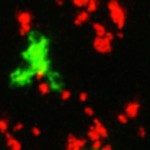Using intravital imaging in a model of B cell lymphoma, we investigated the mechanisms and limitations of anti-CD20 antibody (Ab) therapy.
Anti-CD20 Ab can act through complement-dependent cytotoxicity, Ab-dependent cellular cytotoxicity and Ab-dependent phagocytosis (ADP). We used functional reporters to detect phagocytosis and apoptosis events at the tumor site in a preclinical model of B cell lymphoma. We exploited the distinct pH sensitivity of CFP and YFP to unambiguously identify phagocytosis events by a color change. At the tumor site, the phagocytosis by macrophages was the primary mode of tumor elimination (>90% of tumor cell death), but the number of phagocytosis events dropped abruptly after 1-2hr, resulting in partial tumor depletion. The low macrophages density in tumor-rich areas was also identified as a limiting factor for anti-tumor activity.
Overcoming spatiotemporal bottlenecks in tumor-targeting Ab therapy (increasing macrophage density and prolonging their activity) should thus be considered in order to potentiate treatment efficacy.
Image taken in vivo following the injection of anti-CD20 antibodies, showing cancer cells (in magenta) and macrophages (in green) attacking tumor cells. © Institut Pasteur – Dynamics of Immune Responses Unit
Source
Imaging the mechanisms of anti-CD20 therapy in vivo uncovers spatiotemporal bottlenecks in antibody-dependent phagocytosis, Science Advances, 19 Feb. 2021.
To read the article: here
To read the press release: here





